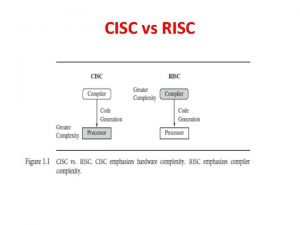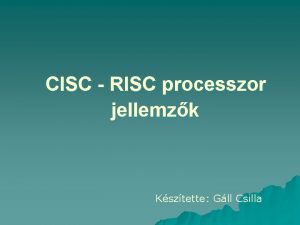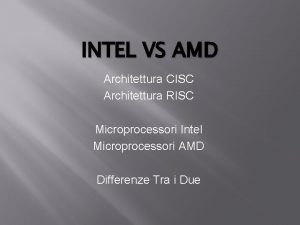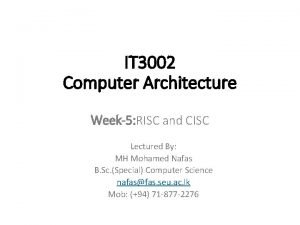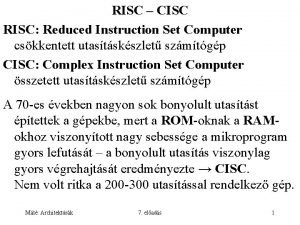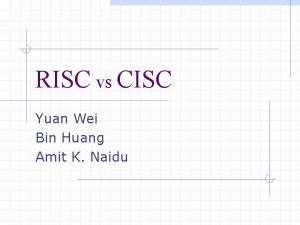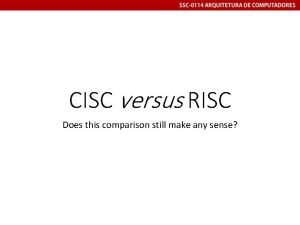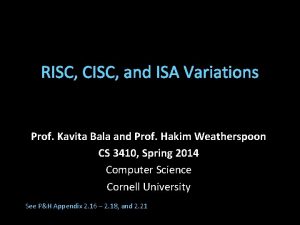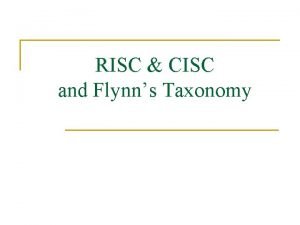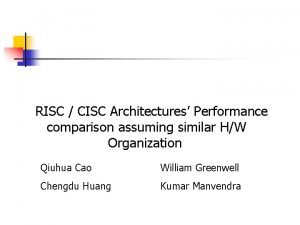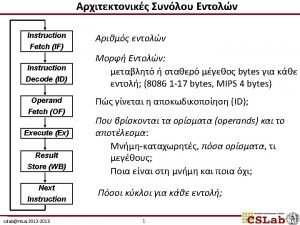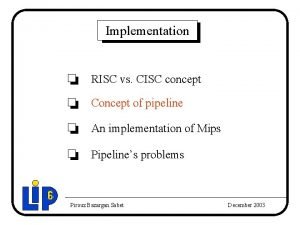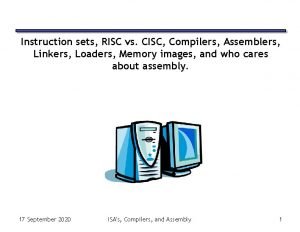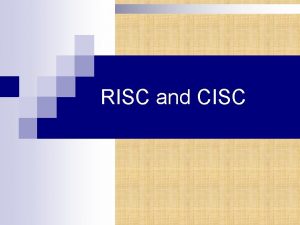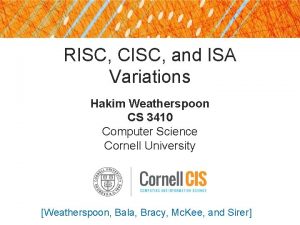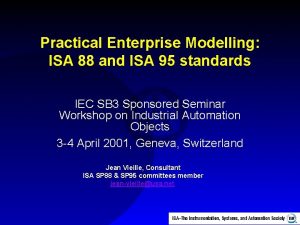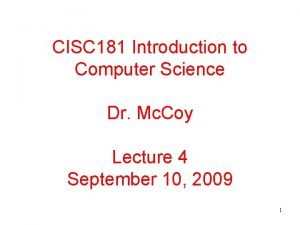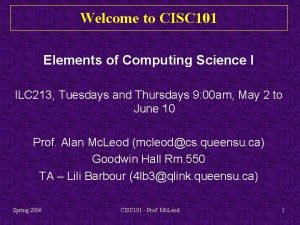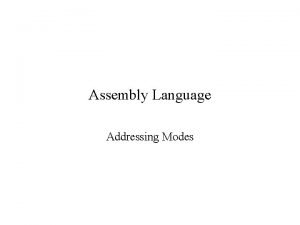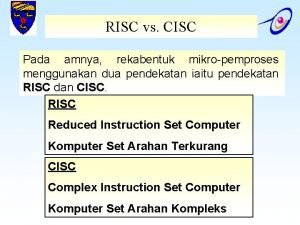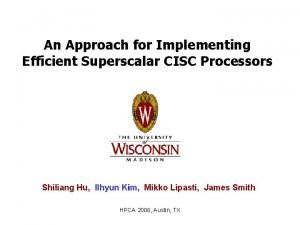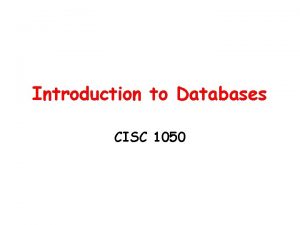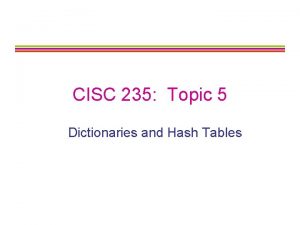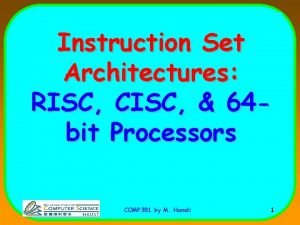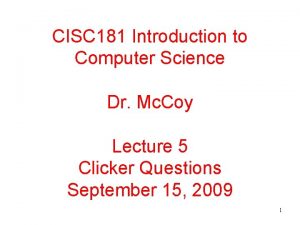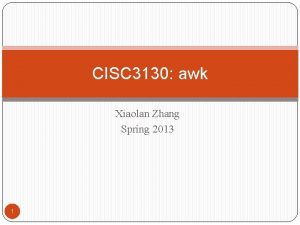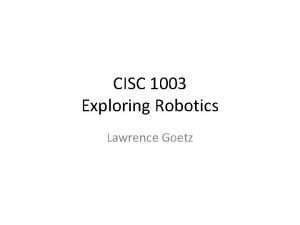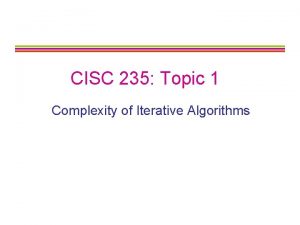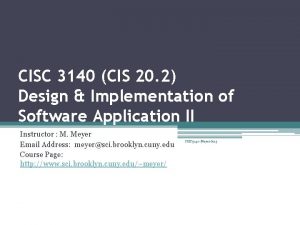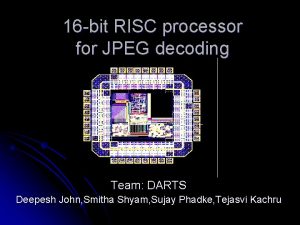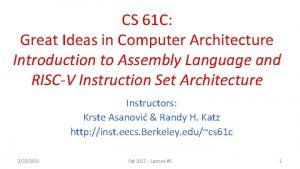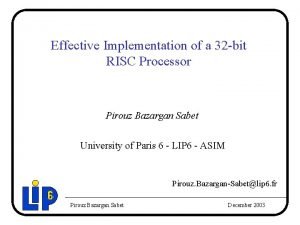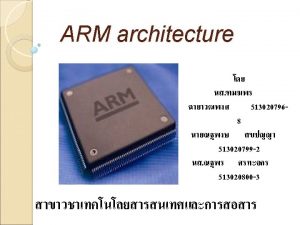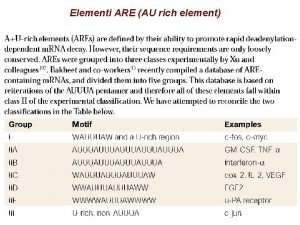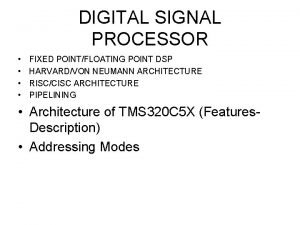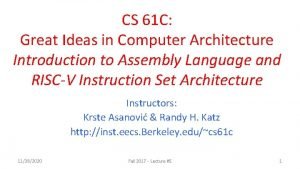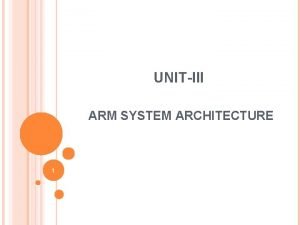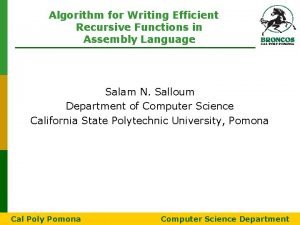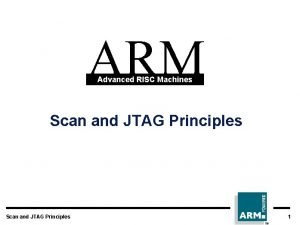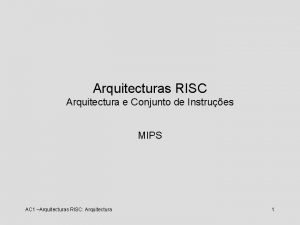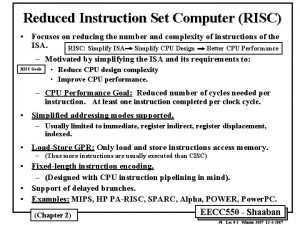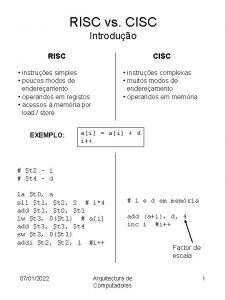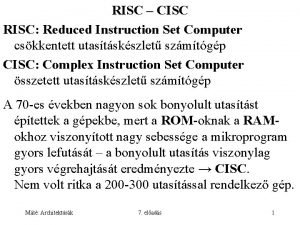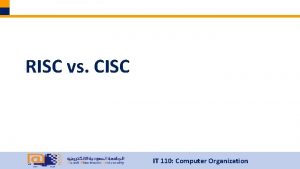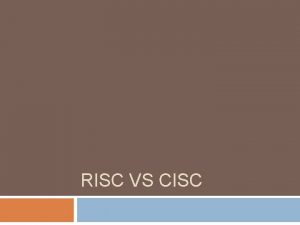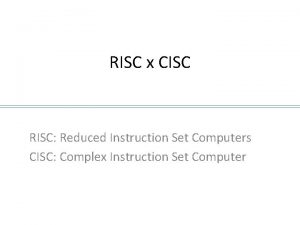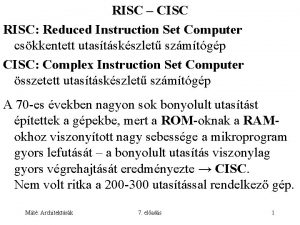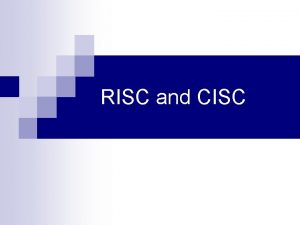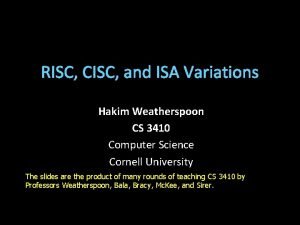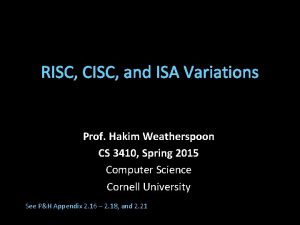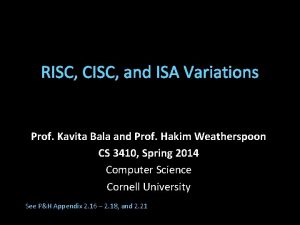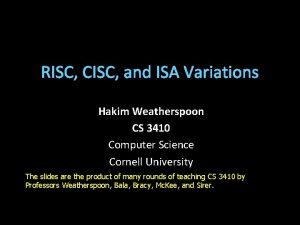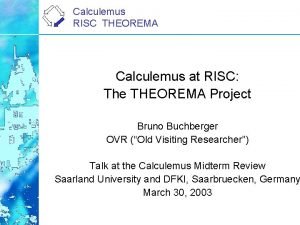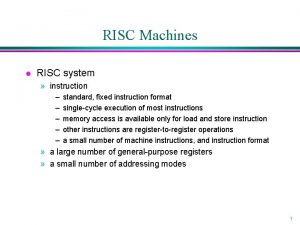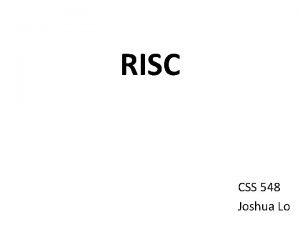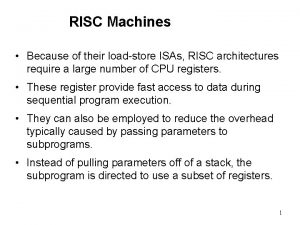ISA Wrap up 1 RISC vs CISC 2











































![Strength reduction Example: for (j = 0; j = n; ++j) A[j] = 2*j; Strength reduction Example: for (j = 0; j = n; ++j) A[j] = 2*j;](https://slidetodoc.com/presentation_image/424e18cf46e32ba175854d58c336c8ca/image-44.jpg)











![Memory Instructions • Load and store instructions • Example: C code: MIPS code: A[12] Memory Instructions • Load and store instructions • Example: C code: MIPS code: A[12]](https://slidetodoc.com/presentation_image/424e18cf46e32ba175854d58c336c8ca/image-56.jpg)





- Slides: 61

ISA (Wrap up) 1

RISC vs. CISC 2

CISC Evolution • Storage and Memory – High cost of memory. – Need for compact code. • Support for high-level languages • Support for new applications (e. g. , multimedia) 3

CISC Effects • Moved complexity from s/w to h/w • Ease of compiler design (HLLCA) • Easier to debug • Lengthened design times • Increased design errors 4

RISC Evolution • Increasingly cheap memory • Improvement in compiler technology Patterson: “Make the common case fast” 5

RISC Effect • Move complexity from h/w to s/w • Provided a single-chip solution • Better use of chip area • Better Speed • Feasibility of pipelining – Single cycle execution stages – Uniform Instruction Format 6

Key arguments • RISC argument – for a given technology, RISC implementation will be faster – current VLSI technology enables single-chip RISC – when technology enables single-chip CISC, RISC will be pipelined – when technology enables pipelined CISC, RISC will have caches – When CISC have caches, RISC will have multiple cores • CISC argument – CISC flaws not fundamental (fixed with more transistors) – Moore’s Law will narrow the RISC/CISC gap (true) – software costs will dominate (very true) 7

Role of Compiler: RISC vs. CISC • CISC instruction: MUL <addr 1>, <addr 2> • RISC instructions: LOAD A, <addr 1> LOAD B, <addr 2> MUL A, B STORE <addr 1> • RISC is dependent on optimizing compilers 8

Example CISC ISA: Intel X 86 12 addressing modes: • • • Register. Immediate. Direct. Base + Displacement. Index + Displacement. Scaled Index + Displacement. Based Index. Based Scaled Index. Based Index + Displacement. Based Scaled Index + Displacement. • Relative. Operand sizes: • Can be 8, 16, 32, 48, 64, or 80 bits long. • Also supports string operations. Instruction Encoding: • The smallest instruction is one byte. • The longest instruction is 12 bytes long. • The first bytes generally contain the opcode, mode specifiers, and register 9 fields.

Example RISC ISA: Power. PC 8 addressing modes: • • Register direct. Immediate. Register indirect with immediate index (loads and stores). Register indirect with register index (loads and stores). Absolute (jumps). Link register indirect (calls). Count register indirect (branches). Operand sizes: • Four operand sizes: 1, 2, 4 or 8 bytes. Instruction Encoding: • Instruction set has 15 different formats with many minor variations. • • All are 32 bits in length. 10

Example RISC ISA: HP-PA Operand sizes: 7 addressing modes: • • Register Immediate Base with displacement Base with scaled index and displacement • Predecrement • Postincrement • PC-relative • Five operand sizes ranging in powers of two from 1 to 16 bytes. Instruction Encoding: • Instruction set has 12 different formats. • • All are 32 bits in length. 11

Example RISC ISA: SPARC 5 addressing modes: • Register indirect with immediate displacement. • Register inderect indexed by another register. • Register direct. • Immediate. • PC relative. Operand sizes: • Four operand sizes: 1, 2, 4 or 8 bytes. Instruction Encoding: • Instruction set has 3 basic instruction formats with 3 minor variations. • All are 32 bits in length. 12

CISC vs. RISC Characteristics • RISC vs. CISC controversy is now 20 years old. • After the initial enthusiasm for RISC machines, there has been a growing realization that – RISC designs may benefit from the inclusion of some CISC features, and – Vice-versa. • The result is that more recent RISC design, Power. PC and SPARC, are no longer "pure" RISC and the more recent CISC designs, notably the Pentium, AMD, and Core Duo incorporate core RISC characteristics. Intel called this hack CRISC. This concept was so moronic that even Intel could not market it! 13

Current Trends • - x 86 instructions decoded into RISC-like instructions (ROps) Intel called this hack CRISC. This concept was so moronic that even Intel could not market it! • IA-64 - dependence on compilers for scheduling • Athlon – both direct execution and microprogrammed instructions 14

Why did Intel (CISC) win? • x 86 won because it was the first 16 -bit chip. • IBM put it in PCs because there was no competing choice • Rest is inertia and “financial feedback” – – – – x 86 is most difficult ISA to implement for high performance, but Because Intel sells the most processors. . . It has the most money. . . Which it uses to hire more and better engineers. . . Which is uses to maintain competitive performance. . . And given equal performance, compatibility wins. . . So Intel sells the most processors. 15

Towards Instruction Set Consolidation IA vision Future innovation should come in micro-architecture enhancements and compatible extensions to dominant instruction sets, rather than the creation of new instruction sets. 1 Is the trend clear? With ever growing software complexity and installed base the value of remaining compatible with and extending existing, dominant instruction sets heavily outweighs any disadvantages. 2 Is the time now? Technology has passed the point where instruction set costs are no longer relevant. 16

What The Euro Can Teach Us • The economic benefits of moving away from multiple currencies is enormous 17

Possible Solutions Port thousands of applications, operating systems, drivers, codecs, tool chains and virtual machines main() { printf(“Hello Worldn”); } x 86 MIPS® STOP ARM Power. PC EPIC SPARC Cell Other • Resource intensive • Slow • Costly to maintain 18

Architectural Evolution Macro. Level Networking Common Instruction Set Architecture Robust security Investment protection Today Built in OS integration Happening Now No need for multiple validations The Future? No need to port Storage Server Desktop Laptop Handheld Ubiquitous 19

Extending x 86 20

EPIC (Explicitly Parallel Instruction Computing) 21

IA- 64: The Itanium Processor • A radical departure from the traditional paradigms. • Intel and Hewlett-Packard Co. designed a new architecture, IA-64, that they expected to be much more effective at executing instructions in parallel • IA-64 is brand new ISA 22

IA - 64 • IA-64 is a 64 -bit. In IA-64 designs, instructions are scheduled by the compiler, not by the hardware. • Much of the logic that groups, schedules, and tracks instructions is not needed thus simplifying the circuitry and promising to improve performance. 23

The EPIC Philosophy • The acronym EPIC stands for Explicitly Parallel Instruction Computing. • The entire EPIC design philosophy can be summed up by the following: make use of parallel power whenever and wherever possible; and if it's not possible, make it possible. 24

The EPIC Philosophy 25

Intel IA-64 • Massive resources – 128 GPRs (64 -bit, plus poison bit) – 128 FPRs (82 -bit) – 64 predicate registers – Also has branch registers for indirect branches • Contrast to: – RISC: 32 int, 32 FP, handful of control regs – x 86: 8 int, 8 fp, handful of control regs • x 86 -64 bumps this to 16, SSE adds 8/16 MM regs 26

IA-64 Registers 27

IA-64 Groups • Compiler assembles groups of instructions – No register data dependencies between insts in the same group • Memory deps may exist – Compiler explicitly inserts “stops” to mark the end of a group – Group can be arbitrarily long 28

IA-64 Bundles • Bundle == The “VLIW” Instruction – 5 -bit template encoding • also encodes “stops” – Three 41 -bit instructions • 128 bits per bundle – average of 5. 33 bytes per instruction • x 86 only needs 3 bytes on average 29

Instruction Types • Instructions are divided into different type – determines which functional units they can execute on – templates are based on these types 30

Bundle Templates • Not all combinations of A, I, M, F, B, L and X are permitted • Group “stops” are explicitly encoded as part of the template – can’t stop just anywhere Some bundles identical except for group stop 31

Individual Instruction Formats • Fairly RISC-like – easy to decode, fields tend to stay put 32

Instruction Format: Bundles & Templates • Bundle • Set of three instructions (41 bits each) • Template • Identifies types of instructions in bundle 33

Explicitly Parallel Instruction Computing EPIC S 2 S 1 S 0 T 128 -bit instruction bundles from I-cache Fetch one or more bundles for execution (Implementation, Itanium® takes two. ) Processor Try to execute all instructions in parallel, depending on available units. functional units MEM INT FP FP B B B Retired instruction bundles 34

The Role of Compilers 35

Compiler and ISA • ISA decisions are no more just for programming assembly language (AL) easily • Due to HLL, ISA is a compiler target today • Performance of a computer will be significantly affected by compiler • Understanding the compiler technology today is critical to designing and efficiently implementing an instruction set • Architecture choice affects the code quality and the complexity of building a compiler for it 36

Goal of the Compiler • Primary goal is correctness • Second goal is speed of the object code • Others: – Speed of the compilation – Ease of providing debug support – Inter-operability among languages – Flexibility of the implementation - languages may not change much but they do evolve - e. g. Fortran 66 ===> HPF Make the frequent cases fast and the rare case correct 37

Typical Modern Compiler Structure Common Intermediate Representation Somewhat language dependent Largely machine independent Small language dependent Slight machine dependent Language independent Highly machine dependent 38

Typical Modern Compiler Structure (Cont. ) • Multi-pass structure easy to write bug-free compilers – Transform HL, more abstract representations, into progressively low-level representations, eventually reaching the instruction set • Compilers must make assumptions about the ability of later steps to deal with certain problems – Ex. 1 choose which procedure calls to expand inline before they know the exact size of the procedure being called – Ex. 2 Global common sub-expression elimination • Find two instances of an expression that compute the same value and saves the result of the first one in a temporary – Temporary must be register, not memory (Performance) – Assume register allocator will allocate temporary into register 39

Optimization Types • High level - done at source code level – Procedure called only once - so put it in-line and save CALL • Local - done on basic sequential block (straight-line code) – Common sub-expressions produce same value – Constant propagation - replace constant valued variable with the constant - saves multiple variable accesses with same value • Global - same as local but done across branches – Code motion - remove code from loops that compute same value on each pass and put it before the loop – Simplify or eliminate array addressing calculations in loop 40

Optimization Types (Cont. ) • Register allocation – Use graph coloring (graph theory) to allocate registers • NP-complete • Heuristic algorithm works best when there at least 16 (and preferably more) registers • Processor-dependent optimization – Strength reduction: replace multiply with shift and add sequence – Pipeline scheduling: reorder instructions to minimize pipeline stalls – Branch offset optimization: Reorder code to minimize branch offsets 41

Register Allocation • One the most important optimizations • Based on graph coloring techniques – Construct graph of possible allocations to a register – Use graph to allocate registers efficiently – Goal is to achieve 100% register allocation for all active variables. – Graph coloring works best when there at least 16 general-purpose registers available for integers and more for floating-point variables. 42

Constant propagation a: = 5; . . . // no change to a so far. if (a > b) {. . . } The statement (a > b) can be replaced by (5 > b). This could free a register when the comparison is executed. When applied systematically, constant propagation can improve the code significantly. 43
![Strength reduction Example for j 0 j n j Aj 2j Strength reduction Example: for (j = 0; j = n; ++j) A[j] = 2*j;](https://slidetodoc.com/presentation_image/424e18cf46e32ba175854d58c336c8ca/image-44.jpg)
Strength reduction Example: for (j = 0; j = n; ++j) A[j] = 2*j; for (i = 0; 4*i <= n; ++i) A[4*i] = 0; An optimizing compiler can replace multiplication by 4 by addition by 4. This is an example of strength reduction. In general, scalar multiplications can be replaced by additions. 44

Major Types of Optimizations and Example in Each Class 45

Change in IC Due to Optimization Ø Level 1: local optimizations, code scheduling, and local register allocation Ø Level 2: global optimization, loop transformation (software pipelining), global register allocation Ø Level 3: + procedure integration 46

How can Architects Help Compiler Writers • Provide Regularity – Address modes, operations, and data types should be orthogonal (independent) of each other • Simplify code generation especially multi-pass • Counterexample: restrict what registers can be used for a certain classes of instructions • Provide primitives - not solutions – Special features that match a HLL construct are often un-usable – What works in one language may be detrimental to others 47

How can Architects Help Compiler Writers (Cont. ) • Simplify trade-offs among alternatives – How to write good code? What is a good code? • Metric: IC or code size (no longer true) caches and pipeline… – Anything that makes code sequence performance obvious is a definite win! • How many times a variable should be referenced before it is cheaper to load it into a register • Provide instructions that bind the quantities known at compile time as constants – Don’t hide compile time constants • Instructions which work off of something that the compiler thinks could be a run-time determined value hand-cuffs the optimizer 48

Short Summary -- Compilers • ISA has at least 16 GPR (not counting FP registers) to simplify allocation of registers using graph coloring • Orthogonality suggests all supported addressing modes apply to all instructions that transfer data • Simplicity – understand that less is more in ISA design – Provide primitives instead of solutions – Simplify trade-offs between alternatives – Don’t bind constants at runtime • Counterexample – Lack of compiler support for multimedia instructions 49

MIPS ISA 50

Growth of Processors • Language of the Machine • We’ll be working with the MIPS instruction set architecture – similar to other architectures developed since the 1980's – Almost 100 million MIPS processors manufactured in 2002 – used by NEC, Nintendo, Cisco, Silicon Graphics, Sony, … 51

MIPS Instruction Set (RISC) • Instructions execute simple functions. • Maintain regularity of format – each instruction is one word, contains opcode and arguments. • Minimize memory accesses – whenever possible use registers as arguments. • Three types of instructions: • Register (R)-type – only registers as arguments. • Immediate (I)-type – arguments are registers and numbers (constants or memory addresses). • Jump (J)-type – argument is an address. 52

MIPS Arithmetic Instructions • All instructions have 3 operands • Operand order is fixed (destination first) Example: C code: a = b + c MIPS ‘code’: add a, b, c (we’ll talk about registers in a bit) “The natural number of operands for an operation like addition is three… requiring every instruction to have exactly three operands conforms to the philosophy of keeping the hardware simple” 53

Arithmetic Instr. (Continued) • Design Principle: simplicity favors regularity. • Of course this complicates some things. . . C code: MIPS code: a = b + c + d; add a, b, c add a, a, d • Operands must be registers (why? ) • 32 registers provided • Each register contains 32 bits 54

Registers vs. Memory • Arithmetic instructions operands must be registers • 32 registers provided • Compiler associates variables with registers. • What about programs with lots of variables? Must use memory. Control Input Memory Datapath Processor Output I/O 55
![Memory Instructions Load and store instructions Example C code MIPS code A12 Memory Instructions • Load and store instructions • Example: C code: MIPS code: A[12]](https://slidetodoc.com/presentation_image/424e18cf46e32ba175854d58c336c8ca/image-56.jpg)
Memory Instructions • Load and store instructions • Example: C code: MIPS code: A[12] = h + A[8]; lw $t 0, 32($s 3) #addr of A in reg s 3 add $t 0, $s 2, $t 0 #h in reg s 2 sw $t 0, 48($s 3) • Can refer to registers by name (e. g. , $s 2, $t 2) instead of number • Store word has destination last • Remember arithmetic operands are registers, not memory! Can’t write: add 48($s 3), $s 2, 32($s 3) 56

Machine Language • Instructions, like registers and words of data, are also 32 bits long – Example: add $t 1, $s 2 – registers have numbers, $t 1=8, $s 1=17, $s 2=18 • Instruction Format: 000000 10001 10010 01000 00000 100000 op funct rs rt rd shamt 57

MIPS 64 Instruction Format I - type instruction 6 5 16 rs rt Immediate Opcode 5 0 5 6 10 11 15 16 31 Encodes: Loads and stores of bytes, words, half words. All immediates (rd ¬ rs op immediate) Conditional branch instructions (rs 1 is register, rd unused) Jump register, jump and link register (rd = 0, rs = destination, immediate = 0) R - type instruction 6 5 Opcode rs 5 5 rt rd 5 shamt 6 func 0 5 6 10 11 15 16 20 21 25 26 Register-register ALU operations: rd ¬ rs func rt Function encodes the data path operation: Add, Sub. . Read/write special registers and moves. J - Type instruction 6 Opcode 31 26 Offset added to PC 0 5 6 Jump and jump and link. Trap and return from exception 31 58

Summary: MIPS Registers and Memory 59

Summary: MIPS Instructions 60

Addressing Modes 2004 © Morgan Kaufman Publishers 61
 Risc vs cisc vs arm
Risc vs cisc vs arm Risc és cisc
Risc és cisc Computer organisation and architecture
Computer organisation and architecture Intel risc
Intel risc Cisc vs risc architecture
Cisc vs risc architecture Risc cisc architecture
Risc cisc architecture Wei bin
Wei bin Define instruction set
Define instruction set Risc vs cisc
Risc vs cisc Isa cisc
Isa cisc Cisc architecture
Cisc architecture Risc
Risc Similarities between risc and cisc
Similarities between risc and cisc Arquitetura risc e cisc
Arquitetura risc e cisc Arduino 168
Arduino 168 Pipeline cisc
Pipeline cisc Arquitectura risc y cisc
Arquitectura risc y cisc What is cisc
What is cisc Pengertian risc
Pengertian risc Isa
Isa Example of isa
Example of isa Isa-95
Isa-95 Wide isa vs narrow isa
Wide isa vs narrow isa Cisc 181
Cisc 181 Cisc 101
Cisc 101 Procesor cisc
Procesor cisc Cisc assembly language
Cisc assembly language Ciri ciri cisc
Ciri ciri cisc Cisc scalar processor
Cisc scalar processor Cisc 1050
Cisc 1050 Cisc 235
Cisc 235 Cisc complex instruction set computer
Cisc complex instruction set computer Risc
Risc Cisc cu boulder
Cisc cu boulder Cisc pipeline
Cisc pipeline Cisc 181
Cisc 181 Cisc 3130
Cisc 3130 Cisc 1003
Cisc 1003 Cisc 235
Cisc 235 Cisc 3140
Cisc 3140 Factori de risc biologici
Factori de risc biologici Registrul riscurilor
Registrul riscurilor 16 bit risc
16 bit risc Risc v members
Risc v members Riscv green card
Riscv green card Risc v architecture tutorial
Risc v architecture tutorial 32 bit risc processor
32 bit risc processor Arm advanced risc machine
Arm advanced risc machine Complesso risc
Complesso risc Digital signal processor architecture
Digital signal processor architecture Gozzo tiroideo
Gozzo tiroideo Tipuri de riscuri in afaceri
Tipuri de riscuri in afaceri Risc v green card
Risc v green card The three hardware extensions arm wraps around the core are
The three hardware extensions arm wraps around the core are Binary search in mips
Binary search in mips Advanced risc machines
Advanced risc machines Risc os
Risc os Arquitectura mips
Arquitectura mips Risc v sw instruction
Risc v sw instruction Risc instruction set example
Risc instruction set example Arm vs risc
Arm vs risc Tipuri de risc
Tipuri de risc
